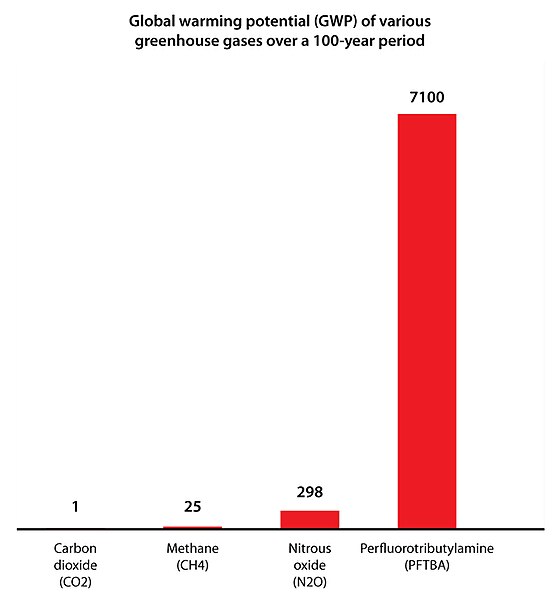Global Warming Potential (GWP) is an index to measure how much infrared thermal radiation a greenhouse gas would absorb over a given time frame after it has been added to the atmosphere. The GWP makes different greenhouse gases comparable with regard to their "effectiveness in causing radiative forcing". It is expressed as a multiple of the radiation that would be absorbed by the same mass of added carbon dioxide, which is taken as a reference gas. Therefore, the GWP has a value of 1 for CO2. For other gases it depends on how strongly the gas absorbs infrared thermal radiation, how quickly the gas leaves the atmosphere, and the time frame being considered.
Comparison of global warming potential (GWP) of three greenhouse gases over a 100-year period: Perfluorotributylamine, nitrous oxide, methane and carbon dioxide (the latter is the reference value, therefore it has a GWP of one)
Greenhouse gases (GHGs) are the gases in the atmosphere that raise the surface temperature of planets such as the Earth. What distinguishes them from other gases is that they absorb the wavelengths of radiation that a planet emits, resulting in the greenhouse effect. The Earth is warmed by sunlight, causing its surface to radiate heat, which is then mostly absorbed by greenhouse gases. Without greenhouse gases in the atmosphere, the average temperature of Earth's surface would be about −18 °C (0 °F), rather than the present average of 15 °C (59 °F).
Comparison of global warming potential (GWP) of three greenhouse gases over a 100-year period: Perfluorotributylamine, nitrous oxide, methane and carbon dioxide (the latter is the reference value, therefore it has a GWP of one)
This 1912 article succinctly describes how burning coal creates carbon dioxide that causes climate change.


